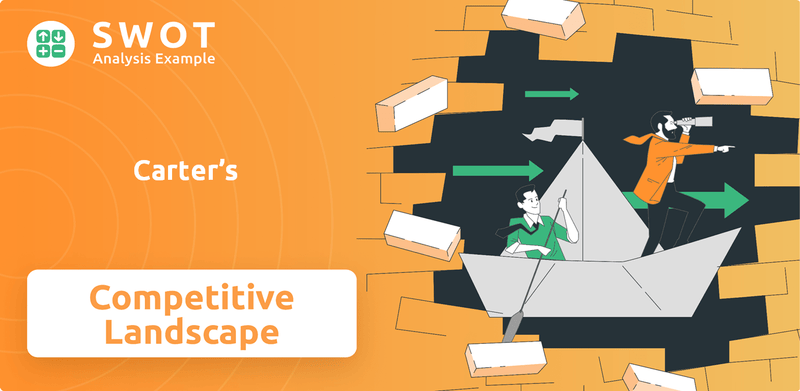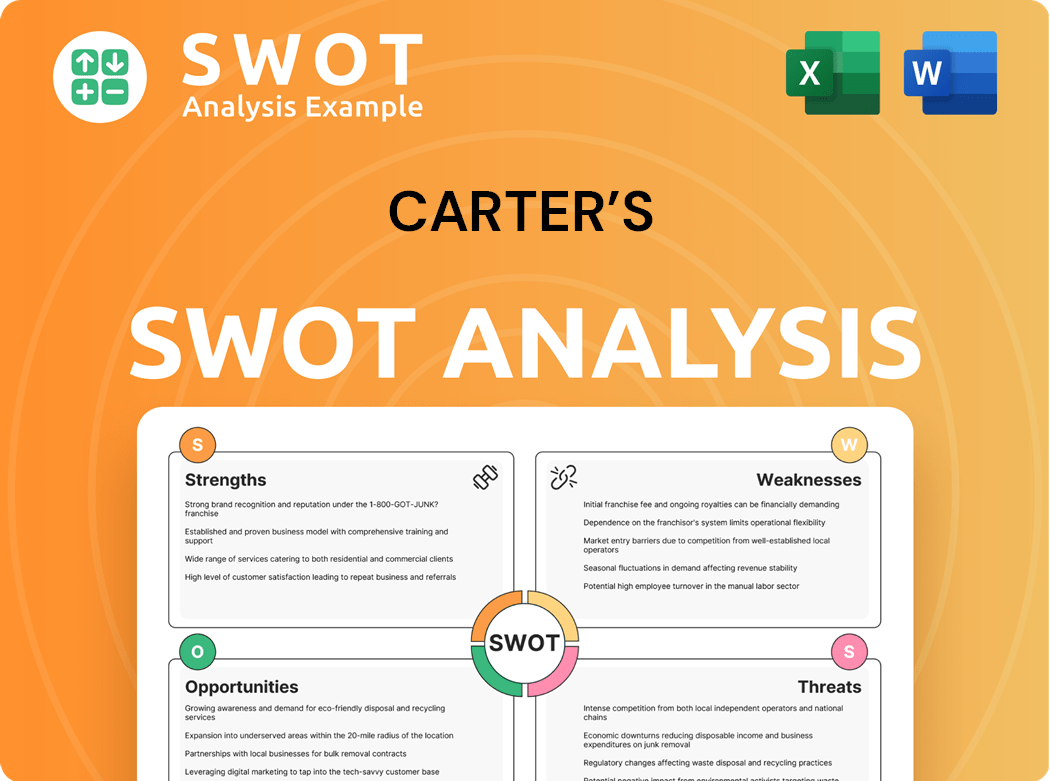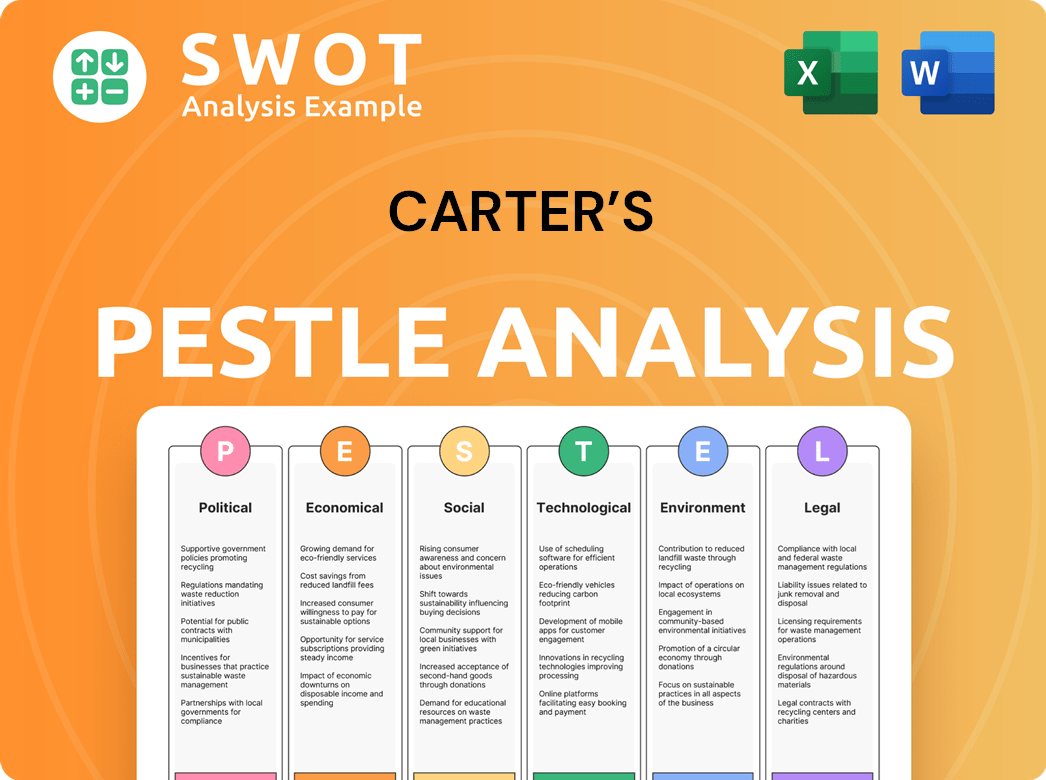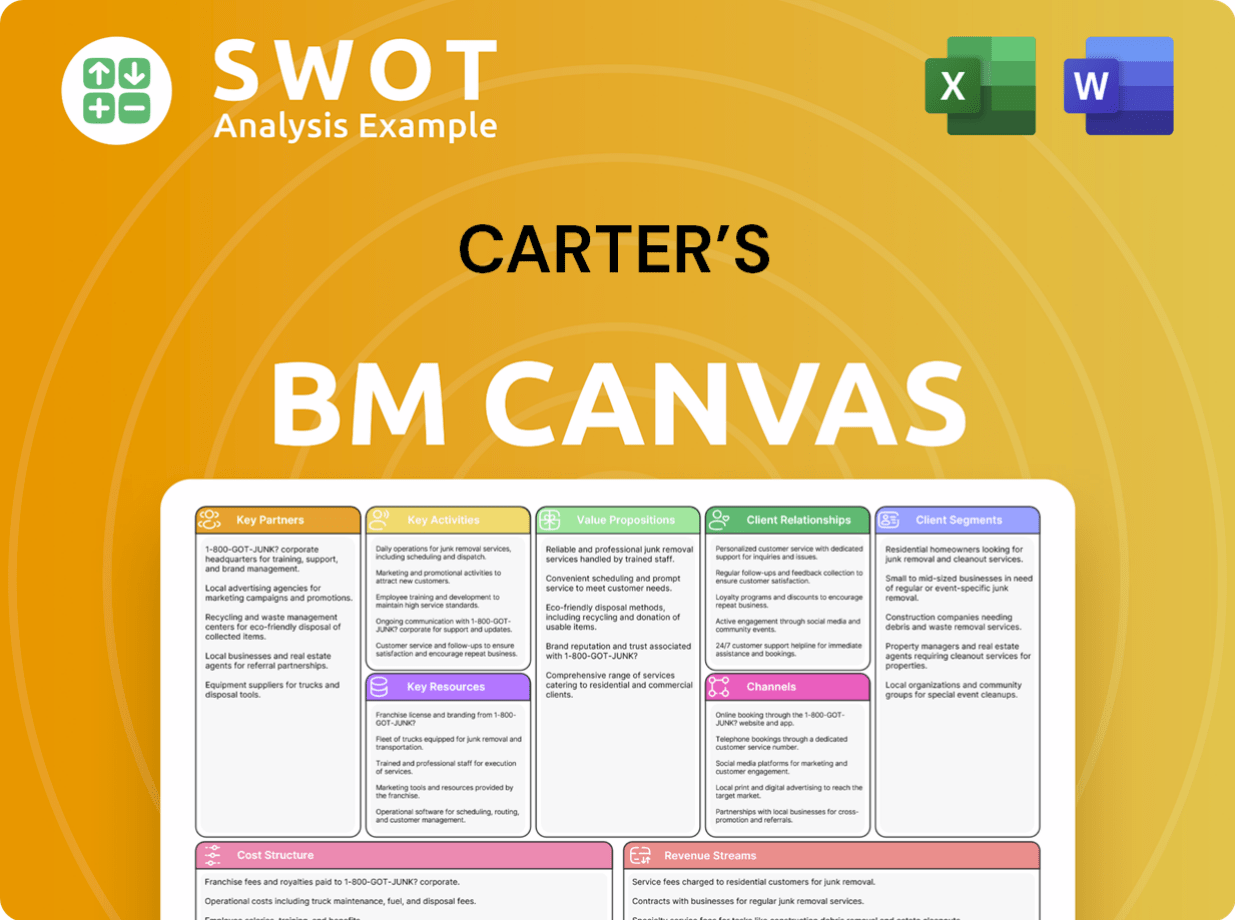Carter’s Bundle
How Does Carter's Dominate the Children's Apparel Market?
The children's apparel industry is a dynamic sector, constantly evolving with fashion trends and consumer demands. Carter's, a long-standing leader, has successfully navigated these changes. Founded in 1865, the company has transformed from a small hosiery business into a global powerhouse. This Carter’s SWOT Analysis will help you understand its strengths.

This exploration of Carter's competitive landscape will delve into its market position, examining key competitors and strategic advantages. We'll conduct a thorough Carter's market analysis, including its financial performance and business strategy. Understanding Carter's competitors and their strategies is crucial for grasping the company's ongoing success in the children's apparel industry.
Where Does Carter’s’ Stand in the Current Market?
Carter's, Inc. holds a leading market position within the children's apparel industry, particularly in the baby and young children's segments. The company's success is built on a solid foundation of brand recognition and a diversified distribution strategy. This includes its own retail stores, e-commerce platforms, and wholesale partnerships. For a deeper understanding of the company's business model, consider reading about the Revenue Streams & Business Model of Carter’s.
The company's primary product lines include bodysuits, sleepwear, playwear, and accessories under its flagship Carter's brand, as well as the OshKosh B'gosh brand. These products cater to a broad customer segment seeking durable and affordable children's wear. Carter's has consistently ranked among the top providers of baby and young children's clothing in North America, demonstrating strong market penetration, especially in the infant and toddler clothing categories.
Geographically, Carter's has a strong presence in the United States and Canada, and has been expanding its international reach. Carter's maintains its focus on value and quality, appealing to a broad customer segment. The company's financial health remains robust, with net sales for fiscal year 2023 reported at approximately $2.97 billion, indicating its substantial scale compared to many industry averages. The company's financial performance is a key factor in its competitive positioning.
Carter's consistently ranks among the top providers of baby and young children's clothing in North America. Specific market share figures for early 2025 are subject to ongoing market analysis. The company's strong brand recognition and market penetration in the infant and toddler clothing categories contribute to its leading position.
Carter's utilizes a diversified distribution strategy to reach its target market. This includes its own retail stores, e-commerce platforms, and wholesale partnerships. These channels enable Carter's to maintain a wide reach and cater to different customer preferences.
Carter's offers a wide range of products, including bodysuits, sleepwear, playwear, and accessories. The company's product offerings are designed to meet the needs of babies and young children. The OshKosh B'gosh brand further expands its product portfolio.
Carter's has a strong presence in the United States and Canada, with a growing international reach. The company's expansion into new markets reflects its strategic growth initiatives. This geographic diversification helps mitigate risks and capture new opportunities.
Carter's competitive advantages include strong brand recognition, a diversified distribution network, and a focus on value and quality. These factors contribute to its ability to maintain a leading market position. Understanding these advantages is crucial for a thorough Carter's market analysis.
- Strong Brand Recognition: The Carter's brand is well-known and trusted by consumers.
- Diversified Distribution: Multiple channels ensure broad market access.
- Value and Quality: Products are durable and affordable, appealing to a wide customer base.
- Financial Performance: Robust financials support continued investment and growth.
Carter’s SWOT Analysis
- Complete SWOT Breakdown
- Fully Customizable
- Editable in Excel & Word
- Professional Formatting
- Investor-Ready Format

Who Are the Main Competitors Challenging Carter’s?
The competitive landscape for Carter's in the children's apparel industry is complex, encompassing both direct and indirect competitors. A thorough Carter's market analysis reveals a dynamic environment where various players vie for market share. Understanding Carter's competitors is crucial for assessing its position and formulating effective Carter's business strategy.
Direct competition primarily comes from brands specializing in children's clothing, while indirect competition includes mass merchandisers and online retailers. The children's apparel industry is subject to constant shifts due to trends, consumer preferences, and economic factors. Analyzing Carter's financial performance in this context provides insights into its ability to adapt and thrive.
The Children's Place is a key direct competitor, offering a wide range of children's apparel through retail and online channels. The company competes on price and trend-driven collections. Old Navy, a Gap Inc. brand, also presents strong competition with its affordable family apparel, leveraging its extensive retail presence and promotional activities. H&M and Zara, known for fast fashion, challenge Carter's, especially in their children's lines, by offering trendy designs at competitive prices.
Direct competitors like The Children's Place and Old Navy focus on similar customer segments. These brands often compete on price, style, and retail presence.
Mass merchandisers such as Walmart and Target offer children's clothing at lower price points. Online retailers like Amazon also present a challenge due to their wide selection and convenience.
The children's apparel market is affected by trends, consumer spending, and economic conditions. Understanding these dynamics is essential for strategic planning.
Key strategies include pricing, product differentiation, and effective distribution. Brands often use promotions and loyalty programs to attract and retain customers.
Direct-to-consumer (DTC) brands focused on sustainability and niche designs are gaining traction. E-commerce continues to grow, influencing retail strategies.
Analyzing financial reports provides insights into each company's market position and profitability. This includes revenue, profit margins, and market share.
Indirect competitors, such as Walmart and Target, leverage their vast retail networks to offer children's clothing at competitive prices. Amazon also plays a significant role, providing a wide selection of brands and convenient e-commerce options. Emerging DTC brands, often emphasizing organic materials or sustainable practices, are also reshaping the landscape. For example, in 2024, the global children's wear market was valued at approximately $200 billion, with projections for continued growth. The competitive landscape is constantly evolving, influenced by mergers, acquisitions, and changing consumer preferences. For further insights into the company's structure, you can read about the Owners & Shareholders of Carter’s.
Several factors influence Carter's competitive landscape, including pricing, product quality, brand recognition, and distribution channels.
- Pricing Strategy: Competitive pricing is crucial, with many brands offering discounts and promotions.
- Product Differentiation: Unique designs, sustainable materials, and specialized product lines help differentiate brands.
- Brand Recognition: Strong brand reputation and customer loyalty significantly impact market share.
- Distribution Channels: Retail presence, e-commerce platforms, and partnerships with other retailers are vital.
Carter’s PESTLE Analysis
- Covers All 6 PESTLE Categories
- No Research Needed – Save Hours of Work
- Built by Experts, Trusted by Consultants
- Instant Download, Ready to Use
- 100% Editable, Fully Customizable

What Gives Carter’s a Competitive Edge Over Its Rivals?
The competitive landscape for Carter's is shaped by its strong brand recognition, extensive distribution network, and economies of scale. These factors contribute significantly to the company's ability to maintain a leading position in the children's apparel industry. Understanding these advantages is crucial for a comprehensive Carter's market analysis and assessing its long-term viability.
Carter's business strategy has consistently focused on leveraging its brand equity and operational efficiencies. The company's brands, including Carter's and OshKosh B'gosh, have established a strong reputation for quality and durability. This brand loyalty is a key differentiator in a market where parents prioritize value and trust. The company's ability to navigate the children's apparel industry is heavily influenced by these strengths.
Examining the competitive advantages of Carter's reveals a multi-faceted approach to market dominance. From its robust distribution network to its efficient supply chain, the company has built a sustainable model. Analyzing these advantages is essential for investors and stakeholders interested in the company's financial performance.
Carter's benefits from exceptionally high brand recognition, cultivated over more than a century. The company's brands, particularly Carter's and OshKosh B'gosh, are well-regarded for quality and durability. This strong brand loyalty translates into repeat purchases and a premium perception among parents, influencing Carter's brand perception vs. competitors.
Carter's boasts a vast and diversified distribution network, including robust e-commerce platforms, company-owned retail stores, and wholesale partnerships. This multi-channel approach ensures broad market penetration and accessibility for consumers. This strategy is crucial for Carter's distribution channels compared to rivals.
As a large-scale operator, Carter's achieves significant economies of scale in sourcing, manufacturing, and marketing. This allows the company to maintain competitive pricing while upholding product quality. Efficient supply chain and operational expertise contribute to cost advantages.
Carter's invests in design and product innovation, consistently offering new collections that align with consumer trends and safety standards. This focus helps the company differentiate itself in a competitive market. The company continuously updates its product lines compared to competition.
Carter's competitive advantages are rooted in its brand recognition, extensive distribution, and economies of scale. The company's focus on product innovation and efficient operations further strengthens its market position. For more insights into Carter's growth strategy, consider reading this article: Growth Strategy of Carter’s.
- Brand Loyalty: High consumer trust and repeat purchases.
- Multi-Channel Distribution: Broad market reach through online, retail, and wholesale channels.
- Cost Efficiency: Economies of scale in sourcing and manufacturing.
- Product Innovation: Continuous updates to align with trends and safety standards.
Carter’s Business Model Canvas
- Complete 9-Block Business Model Canvas
- Effortlessly Communicate Your Business Strategy
- Investor-Ready BMC Format
- 100% Editable and Customizable
- Clear and Structured Layout

What Industry Trends Are Reshaping Carter’s’s Competitive Landscape?
Understanding the competitive landscape of Carter's involves analyzing industry trends, future challenges, and potential opportunities. The children's apparel industry is dynamic, shaped by evolving consumer preferences, technological advancements, and global market dynamics. A thorough Carter's market analysis is essential for strategic decision-making.
The industry faces both headwinds and tailwinds. Factors such as sustainability concerns, e-commerce growth, and global expansion opportunities are significant influences. Conversely, economic uncertainties, supply chain disruptions, and intense competition pose considerable challenges. This overview will explore these aspects in detail to provide a comprehensive view of Carter's competitive position.
The children's apparel industry is seeing a rise in demand for sustainable and ethically produced clothing. Consumers are increasingly conscious of environmental impacts and labor practices, leading to a shift towards organic materials and transparent supply chains. E-commerce and digital engagement continue to grow, requiring companies to optimize their online customer experience.
Future challenges include fluctuating birth rates in key markets, supply chain disruptions, and intense price competition from mass-market retailers. Economic downturns can also impact consumer spending on non-essential items like apparel. Managing these challenges requires strategic agility and robust risk management.
Opportunities include expanding into emerging international markets with higher birth rates and growing middle classes. Product innovation, such as developing smart clothing or expanding into related categories like toys, presents avenues for diversification. Strategic partnerships can further strengthen market position.
Carter's competitive advantages include a strong brand reputation and established distribution networks. The company's focus on quality and value, along with its ability to adapt to changing consumer preferences, contributes to its competitive edge. These advantages are crucial for maintaining market share.
To remain resilient in a dynamic industry, Carter's should emphasize sustainability, digital integration, and global market expansion. Investing in eco-friendly product lines and enhancing digital marketing strategies are crucial. Strategic partnerships and market diversification can further strengthen its position.
- Expand eco-friendly product lines to meet consumer demand.
- Enhance digital customer experience through data analytics and omnichannel capabilities.
- Explore growth opportunities in emerging international markets.
- Develop strategic partnerships for market expansion and innovation.
Carter’s Porter's Five Forces Analysis
- Covers All 5 Competitive Forces in Detail
- Structured for Consultants, Students, and Founders
- 100% Editable in Microsoft Word & Excel
- Instant Digital Download – Use Immediately
- Compatible with Mac & PC – Fully Unlocked

Related Blogs
- What are Mission Vision & Core Values of Carter’s Company?
- What is Growth Strategy and Future Prospects of Carter’s Company?
- How Does Carter’s Company Work?
- What is Sales and Marketing Strategy of Carter’s Company?
- What is Brief History of Carter’s Company?
- Who Owns Carter’s Company?
- What is Customer Demographics and Target Market of Carter’s Company?
Disclaimer
All information, articles, and product details provided on this website are for general informational and educational purposes only. We do not claim any ownership over, nor do we intend to infringe upon, any trademarks, copyrights, logos, brand names, or other intellectual property mentioned or depicted on this site. Such intellectual property remains the property of its respective owners, and any references here are made solely for identification or informational purposes, without implying any affiliation, endorsement, or partnership.
We make no representations or warranties, express or implied, regarding the accuracy, completeness, or suitability of any content or products presented. Nothing on this website should be construed as legal, tax, investment, financial, medical, or other professional advice. In addition, no part of this site—including articles or product references—constitutes a solicitation, recommendation, endorsement, advertisement, or offer to buy or sell any securities, franchises, or other financial instruments, particularly in jurisdictions where such activity would be unlawful.
All content is of a general nature and may not address the specific circumstances of any individual or entity. It is not a substitute for professional advice or services. Any actions you take based on the information provided here are strictly at your own risk. You accept full responsibility for any decisions or outcomes arising from your use of this website and agree to release us from any liability in connection with your use of, or reliance upon, the content or products found herein.